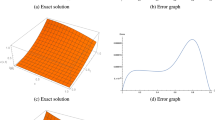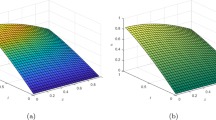Abstract
A numerical method based on Chebyshev polynomials and wavelet theory to solve the generalized Thomas-Fermi boundary value problems is proposed numerically. First, we convert the generalized Thomas-Fermi boundary value problem into the equivalent integral equation. The collocation technique based on Chebyshev wavelets is applied to obtain a nonlinear system that is then dealt with the Newton-Raphson method. We also discuss the convergence and the error bound of the current process. The exactness of the present method is tested by computing the \(L_{\infty }\) and the \(L_2\)-norm errors of several numerical problems. The obtained results are compared with the precise solution and the results obtained by the other known techniques. The advantage of the Chebyshev wavelet collocation method is that it yields better accuracy for a smaller number of collocation points.




Similar content being viewed by others
References
Thomas LH (1927) The calculation of atomic fields. Proc Camb Philos Soc 23:542
Fermi E (1927) Un metodo statistico per la determinazione di alcune priorieta dell’atome. Rendiconti Accademia Nazionale Lincei 32(6):602–607
Chan C, Hon Y (1987) A constructive solution for a generalized Thomas-Fermi theory of ionized atoms. Q Appl Math 45(3):591–599
Banerjee B, Constantinescu D, Rehak P (1974) Thomas-Fermi and Thomas-Fermi-Dirac calculations for atoms in a very strong magnetic field. Phys Rev D 10(8):2384
Coulson CA, March NH (1950) Momenta in atoms using the Thomas-Fermi method. Proc Phys Soc Sect A 63(4):367
March N (1952) Thomas-Fermi fields for molecules with tetrahedral and octahedral symmetry. Math Proc Camb Philos Soc 48(4):665–682
March N, Tomishima Y (1979) Behavior of positive ions in extremely strong magnetic fields. Phys Rev D 19(2):449
Umeda K, Tomishima Y (1955) On the influence of the packing on the atomic scattering factor based on the Thomas-Fermi theory. J Phys Soc Jpn 10(9):753–758
Adomian G (1998) Solution of the Thomas-Fermi equation. Appl Math Lett 11(3):131–133
Zaitsev N, Matyushkin I, Shamonov D (2004) Numerical solution of the Thomas-Fermi equation for the centrally symmetric atom. Russ Microelectron 33(5):303–309
Desaix M, Anderson D, Lisak M (2004) Variational approach to the Thomas-Fermi equation. Eur J Phys 25(6):699
Marinca V, Herişanu N (2011) An optimal iteration method with application to the Thomas-Fermi equation. Open Phys 9(3):891–895
Tisdell CC, Holzer M (2015) Analysis of the boundary value problem associated with the nonrelativistic Thomas-Fermi equation for heavy atoms in intense magnetic fields. Differ Equ Appl 7:27–41
Raja MAZ, Zameer A, Khan AU, Wazwaz AM (2016) A new numerical approach to solve Thomas-Fermi model of an atom using bio-inspired heuristics integrated with sequential quadratic programming. Springer Plus 5(1):1400
Parand K, Yousefi H, Delkhosh M, Ghaderi A (2016) A novel numerical technique to obtain an accurate solution to the Thomas-Fermi equation. Eur Phys J Plus 131(7):228
Parand K, Mazaheri P, Yousefi H, Delkhosh M (2017) Fractional order of rational jacobi functions for solving the non-linear singular Thomas-Fermi equation. Eur Phys J Plus 132(2):77
Rosu HC, Mancas SC (2017) Generalized Thomas-Fermi equations as the Lampariello class of Emden-Fowler equations. Phys A Stat Mech Appl 471:212–218
Bobisud L (1990) Existence of solutions for nonlinear singular boundary value problems. Appl Anal 35(1–4):43–57
Pandey RK, Verma AK (2008) Existence-uniqueness results for a class of singular boundary value problems arising in physiology. Nonlinear Anal Real World Appl 9(1):40–52
Pandey RK, Verma AK (2008) Existence-uniqueness results for a class of singular boundary value problems-II. J Math Anal Appl 338:1387–1396
Chandrasekhar S (1939) An introduction to the study of stellar structure. Ciel et Terre 55:412
McElwain D (1978) A re-examination of oxygen diffusion in a spherical cell with Michaelis-Menten oxygen uptake kinetics. J Theor Biol 71(2):255–263
Gray B (1980) The distribution of heat sources in the human head: theoretical considerations. J Theor Biol 82(3):473–476
Chawla M, Katti C (1982) Finite difference methods and their convergence for a class of singular two point boundary value problems. Numerische Mathematik 39(3):341–350
Pandey R (1992) On the convergence of a finite difference method for a class of singular two point boundary value problems. Int J Comput Math 42:237–241
Kumar M (2002) A three-point finite difference method for a class of singular two-point boundary value problems. J Comput Appl Math 145(1):89–97
Iyengar S, Jain P (1986) Spline finite difference methods for singular two point boundary value problems. Numerische Mathematik 50(3):363–376
Rashidinia J, Mahmoodi Z, Ghasemi M (2007) Parametric spline method for a class of singular two-point boundary value problems. Appl Math Comput 188(1):58–63
Kanth AR (2007) Cubic spline polynomial for non-linear singular two-point boundary value problems. Appl Math Comput 189(2):2017–2022
Dehghan M, Shakeri F (2008) Approximate solution of a differential equation arising in astrophysics using the variational iteration method. New Astron 13(01):53–59
Parand K, Dehghan M, Rezaei AR, Ghaderi SM (2010) An approximation algorithm for the solution of the nonlinear Lane-Emden type equations arising in astrophysics using Hermite functions collocation method. Comput Phys Commun 181(06):1096–1108
Singh R, Kumar J, Nelakanti G (2012) New approach for solving a class of doubly singular two-point boundary value problems using Adomian decomposition method. Adv Numer Anal 2012:1–22. https://doi.org/10.1155/2012/541083
Parand K, Dehghan M, Pirkhedri A (2013) The Sinc-collocation method for solving the Thomas-Fermi equation. J Comput Appl Math 237(01):244–252
Taghavi A, Pearce S (2013) A solution to the Lane-Emden equation in the theory of stellar structure utilizing the Tau method. Math Methods Appl Sci 36(10):1240–1247
Lakestani M, Dehghan M (2013) Four techniques based on the B-spline expansion and the collocation approach for the numerical solution of the Lane-Emden equation. Math Methods Appl Sci 36(16):2243–2253
Singh R, Kumar J, Nelakanti G (2013) Numerical solution of singular boundary value problems using Green function and improved decomposition method. J Appl Math Comput 43(1–2):409–425
Mohammadzadeh R, Lakestani M, Dehghan M (2014) Collocation method for the numerical solutions of Lane-Emden type equations using cubic Hermite spline functions. Math Methods Appl Sci 37(9):1303–1717
Singh R, Kumar J (2014) An efficient numerical technique for the solution of nonlinear singular boundary value problems. Comput Phys Commun 185(4):1282–1289
Singh R, Kumar J, Nelakanti G (2014) Approximate series solution of singular boundary value problems with derivative dependence using Green’s function technique. Comput Appl Math 33(2):451–467
Singh R, Kumar J (2014) The Adomian decomposition method with Green’s function for solving nonlinear singular boundary value problems. J Appl Math Comput 44(1–2):397–416
Singh R, Wazwaz AM, Kumar J (2016) An efficient semi-numerical technique for solving nonlinear singular boundary value problems arising in various physical models. Int J Comput Math 93(8):1330–1346
Zhou F, Xu X (2016) Numerical solutions for the linear and nonlinear singular boundary value problems using Laguerre wavelets. Adv Differ Equations 2016(1):17
Turkyilmazoglu M (2017) Solution of initial and boundary value problems by an effective accurate method. Int J Comput Methods 14(06):1750069
Singh R, Das N, Kumar J (2017) The optimal modified variational iteration method for the Lane-Emden equations with Neumann and Robin boundary conditions. Eur Phys J Plus 132(6):251
Singh R (2018) Optimal homotopy analysis method for the non-isothermal reaction-diffusion model equations in a spherical catalyst. J Math Chem 56(9):2579–2590
Singh R (2018) Analytical approach for computation of exact and analytic approximate solutions to the system of Lane-Emden-Fowler type equations arising in astrophysics. Eur Phys J Plus 133(8):320
Verma AK, Kayenat S (2018) On the convergence of Mickens’ type nonstandard finite difference schemes on Lane-Emden type equations. J Math Chem 56(6):1667–1706
Singh R (2019) Analytic solution of singular Emden-Fowler-type equations by Green’s function and homotopy analysis method. Eur Phys J Plus 134(11):583
Singh R, Wazwaz AM (2019) An efficient algorithm for solving coupled Lane-Emden boundary value problems in catalytic diffusion reactions: the homotopy analysis method. MATCH Commun Math Comput Chem 81(3):785–800
Singh R (2019) A modified homotopy perturbation method for nonlinear singular Lane-Emden equations arising in various physical models. Int J Appl Comput Math 5(3):64
Singh R, Garg H, Guleria V (2019) Haar wavelet collocation method for Lane-Emden equations with Dirichlet, Neumann and Neumann-Robin boundary conditions. J Comput Appl Math 346:150–161
Singh R, Shahni J, Garg H, Garg A (2019) Haar wavelet collocation approach for Lane-Emden equations arising in mathematical physics and astrophysics. Eur Phys J Plus 134(11):548
Raja MAZ, Mehmood J, Sabir Z, Nasab AK, Manzar MA (2019) Numerical solution of doubly singular nonlinear systems using neural networks-based integrated intelligent computing. Neural Comput Appl 31(3):793–812
Verma AK, Tiwari D (2019) Higher resolution methods based on quasilinearization and Haar wavelets on Lane-Emden equations. Int J WaveletsMultiresolution Inf Process 17(03):1950005
Singh R, Guleria V, Singh M (2020) Haar wavelet quasilinearization method for numerical solution of Emden-Fowler type equations. Math Comput Simul 174:123–133
Chapwanya M, Dozva R, Muchatibaya G (2019) A nonstandard finite difference technique for singular Lane-Emden type equations. Eng Comput 36(5):1566–1578
Kumar M (2020) Numerical solution of singular boundary value problems using advanced Adomian decomposition method. Eng Comput. https://doi.org/10.1007/s00366-020-00972-6
Shahni J, Singh R (2020) An efficient numerical technique for Lane-Emden-Fowler boundary value problems: Bernstein collocation method. Eur Phys J Plus 135(06):1–21
Shahni J, Singh R (2020) Numerical results of Emden-Fowler boundary value problems with derivative dependence using the Bernstein collocation method. Eng Comput. https://doi.org/10.1007/s00366-020-01155-z
Saadatmandi A, Dehghan M (2008) The numerical solution of problems in calculus of variation using Chebyshev finite difference method. Phys Lett A 372(22):4037–4040
Adibi H, Assari P (2010) Chebyshev wavelet method for numerical solution of Fredholm integral equations of the first kind. Math Probl Eng. https://doi.org/10.1155/2010/138408
Biazar J, Ebrahimi H (2012) Chebyshev wavelets approach for nonlinear systems of Volterra integral equations. Comput Math Appl 63(3):608–616
Yang C, Hou J (2013) Chebyshev wavelets method for solving Bratu’s problem. Boundary Value Problems 2013(1):142
Celik I (2013) Numerical solution of differential equations by using Chebyshev wavelet collocation method. Çankaya Üniversitesi Bilim ve Mühendislik Dergisi 10(2):169–184
Sahu PK, Saha RS (2017) Chebyshev wavelet method for numerical solutions of integro-differential form of Lane-Emden type differential equations. Int J Wavelets Multiresolution Inf Process 15(02):1750015
Secer A, Bakir Y (2019) Chebyshev wavelet collocation method for Ginzburg-Landau equation. Therm Sci 23(1):57–65
Awashie GE, Amoako-Yirenkyi P, Dontwi IK (2019) Chebyshev wavelets collocation method for simulating a two-phase flow of immiscible fluids in a reservoir with different capillary effects. J Petrol Explor Prod Technol 9(3):2039–2051
Assari P, Dehghan M (2019) Application of dual-Chebyshev wavelets for the numerical solution of boundary integral equations with logarithmic singular kernels. Eng Comput 35(1):175–190
Assari P, Dehghan M (2020) The numerical solution of nonlinear weakly singular Fredholm integral equations based on the dual-Chebyshev wavelets. Appl Comput Math 19(1):3–19
Daubechies I (1992) Ten lectures on wavelets. Society for Industrial and Applied Mathematics, Philadelphia, p 61 (ISBN: 978-0-89871-274-2ISBN: 978-0-89871-274-2)
Alpert BK (1993) A class of bases in \(L^{2}\) for the sparse representation of integral operators. SIAM J Math Anal 24(1):246–262
Guf JS, Jiang WS (1996) The Haar wavelets operational matrix of integration. Int J Syst Sci 27(7):623–628
Dennis JE Jr, Schnabel RB (1983) Numerical methods for unconstrained optimization and nonlinear equations. Prentice-Hall, Englewood Cliffs, p 378
Dahlquist G, Björck A (2008) Numerical methods in scientific computing, vol 1. SIAM, Philadelphia
Singh R, Kumar J (2013) Solving a class of singular two-point boundary value problems using new modified decomposition method. ISRN Comput Math 2013:1–11
Duggan R, Goodman A (1986) Pointwise bounds for a nonlinear heat conduction model of the human head. Bull Math Biol 48(2):229–236
Lin S (1976) Oxygen diffusion in a spherical cell with nonlinear oxygen uptake kinetics. J Theor Biol 60(2):449–457
Acknowledgements
First author of this paper is thankful to the INSPIRE Fellowship under INSPIRE Program of Department of Science and Technology, New Delhi, India for the financial support to carry out this research work.
Author information
Authors and Affiliations
Corresponding author
Additional information
Publisher's Note
Springer Nature remains neutral with regard to jurisdictional claims in published maps and institutional affiliations.
Rights and permissions
About this article
Cite this article
Shahni, J., Singh, R. A fast numerical algorithm based on Chebyshev-wavelet technique for solving Thomas-Fermi type equation. Engineering with Computers 38 (Suppl 4), 3409–3422 (2022). https://doi.org/10.1007/s00366-021-01476-7
Received:
Accepted:
Published:
Issue Date:
DOI: https://doi.org/10.1007/s00366-021-01476-7
Keywords
- Thomas-Fermi equation
- Chebyshev wavelet
- Wavelet approximation
- Green’s function
- Collocation method
- Error analysis




